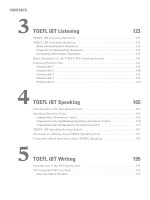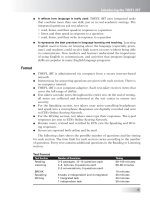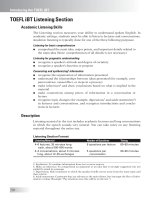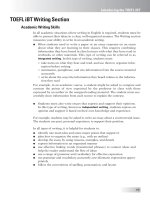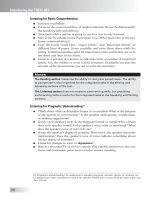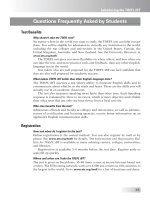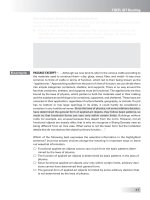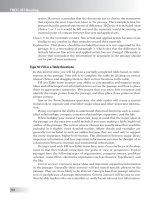Ebook Pocket guide to critical care pharmacotherapy (2nd edition): Part 2
Bạn đang xem bản rút gọn của tài liệu. Xem và tải ngay bản đầy đủ của tài liệu tại đây (847.01 KB, 80 trang )
Chapter 6
Endocrinology
Table 6.1 Management of diabetic ketoacidosis and hyperosmolar
hyperglycemic state
•
•
•
Identify precipitating factors
○
Infection, acute coronary syndrome, cerebrovascular accidents,
trauma, noncompliance with insulin pharmacotherapy, newonset diabetes mellitus, and medications (e.g., corticosteroids and
sympathomimetics)
Prepare a comprehensive flow sheet with vitals, laboratory data, fluid
type and rates, insulin rates, and other treatments
Correct fluid abnormalities
○
Upon presentation: normal saline infused at 15–20 mL/kg/h
(providing 1–1.5 L in the first hour), then 4–14 mL/kg/h for most
patients
■
Use clinical variables (e.g., blood pressure, heart rate, skin
temperature) to target euvolemia; urine output may not be
reliable in the hyperglycemic patient
■
Monitor for hyperchloremic metabolic acidosis
○
If serum sodium rises above 145–150 mEq/L, switch to hypotonic
fluid replacement (i.e., 0.45 % saline). Lactated Ringer’s solution
may prolong ketoacid production by promoting alkalinization
■
Serum sodium may rise with insulin and isotonic saline
fluid administration; estimate the corrected serum sodium
concentration at presentation:
□
Add 1.6 mEq/L to the measured serum sodium for every
100 mg/dL rise in blood glucose > 200 mg/dL
○
When blood glucose falls to ≤ 200 mg/dL, switch to D5W, D5W/1/2
NS, or D5W/NS depending on plasma sodium concentration
(continued)
J. Papadopoulos, Pocket Guide to Critical Care
Pharmacotherapy, DOI 10.1007/978-1-4939-1853-9_6,
© Springer Science+Business Media New York 2015
87
88
6 Endocrinology
Table 6.1 (continued)
•
•
Regular insulin
○
Do not initiate insulin therapy if the serum
potassium < 3.5 mEq/L. Maintain potassium levels between 4 and
5 mEq/L during insulin infusion therapy
○
Prepare 100 units of regular insulin in 100 mL normal saline (new
tubing should be primed with 20 mL of the infusion)
○
Use an ideal body weight to dose insulin in obese patients
○
Bolus with 0.1 units/kg IV, then 0.05–0.1 units/kg/h continuous IV
infusion
■
Consider withholding the insulin bolus in the setting of shock
until resuscitation is underway; rapid lowering of blood glucose
can precipitate worsening of the hypovolemia state
■
If blood glucose does not decrease by at least 10 % in the first
hour, administer 0.14 units/kg regular insulin bolus then adjust
the continuous infusion
○
Goal is to reduce blood glucose by 50–150 mg/dL/h. Use an
institution dose adjustment protocol to titrate the insulin infusion
○
Continue the insulin infusion until acidosis is corrected (i.e., anion
gap closes)
■
Maintain blood glucose between 150 and 200 mg/dL
○
Monitor blood glucose every hour. Once blood glucose is within the
range of 150–200 mg/dL on three consecutive measurements and the
anion gap closes, monitor blood glucose every 2 h
■
If hypoglycemia develops in the setting of continued
ketoacidosis, lower the insulin infusion and administer glucose
infusions to maintain euglycemia. Do not stop the insulin
infusion
○
Monitor anion gap as often as necessary (e.g., every 4 h)
Transition to long acting insulin (e.g., insulin glargine) once ketoacidosis
has resolved, blood glucose ≤ 200 mg/dL, and the patient is eating.
Different methods exists; one example is provided below:
○
Initiate long acting insulin 2 h prior to stopping the insulin infusion,
then daily at the same time each day
○
Estimate total daily dose of insulin: when the decision is made
to transition, evaluate the last 7 insulin drip rates and omit the 2
highest rates; add the 5 lowest insulin drip rates and multiply by
4 = total daily dose of insulin
○
Divide the total daily dose of insulin proportionally into the basal
and prandial bolus components (note: patient may also need
prandial correctional insulin)
○
Basal insulin: total daily dose divided by 2 = units of insulin glargine
SQ q24h (note: maximal initial dose of 50 units daily)
○
Prandial bolus: total daily dose divided by 6 = units of insulin aspart
SQ before each meal
(continued)
Table 6.1 (continued)
•
•
•
•
•
Hypoglycemia management
○
If blood glucose < 70 mg/dL and the patient has normal mental status
and is able to swallow, administer glucose 40 % oral gel 15 g PO
q10 min prn; repeat blood glucose measurement in 15 min
○
If blood glucose < 70 mg/dL and the patient is NPO or if < 100 mg/
dL and the patient has an altered mental status, administer dextrose
50 % 50 mL IVP q10 min prn; repeat blood glucose in 10 min
Monitor and correct potassium, phosphorus, and magnesium
Bicarbonate therapy (if desired)
○
No proven benefit except for concomitant symptomatic hyperkalemia
○
Goal is to increase the pH > 7.2
○
Monitor arterial or venous pH hourly
○
Do not overcorrect pH as acetoacetate and β-hydroxybutyrate are
metabolized to bicarbonate
Administer all intravenous medications in saline where possible
Monitor for evidence of cerebral edema, noncardiogenic pulmonary
edema, acute respiratory distress syndrome, hyperchloremic metabolic
acidosis, and vascular thrombosis
Table 6.2 Management of thyrotoxic crisis and myxedema coma
Thyrotoxic crisis
• Supportive care
○
Control hyperthermia with acetaminophen and cooling blanket
■
Avoid aspirin, as it may increase free T4 and T3 levels by
interfering with plasma–protein binding
○
Fluid resuscitation
• Propylthiouracil (preferred thionamide, as it blocks peripheral
conversion of T4 → T3)
○
200 mg enterally every 4–6 h. Reduce dose once signs/symptoms are
controlled. Usual maintenance dose is 100–150 mg q8h
○
Alternative—methimazole 30 mg enterally every 6–8 h. Reduce
dose once signs/symptoms are controlled. Usual maintenance dose is
15–60 mg daily in three equally divided doses
• Lugol’s solution 10 drops or 1 mL in water q8h
○
Alternative—saturated solution of potassium iodide (SSKI) 5–10
drops in water q8h
○
Use iodine solutions at least 1–2 h after a thionamide
• β-adrenergic blockers
○
Adjust dose to achieve heart rate ≤ 100 beats/min
○
Cautious use in setting of heart failure related to systolic dysfunction
○
Propranolol 0.5–1 mg slow intravenous push (IVP) up to a total of
5 mg, then 20–80 mg enterally q6h
○
Esmolol may be utilized if a rapid short-acting agent is needed
• Hydrocortisone 100 mg IV q8h or 50 mg IV q6h until adrenal
suppression is excluded. Also blocks peripheral conversion of T4 → T3
• Consider plasmapheresis if intractable symptoms
(continued)
90
6 Endocrinology
Table 6.2 (continued)
Myxedema coma
• Supportive care
○
Rewarm passively with a blanket; active rewarming may cause
distributive shock
○
Treat hypotension with fluids and vasopressor support. Consider
adrenal insufficiency
○
Manage hyponatremia if present
• Levothyroxine (T4) 200–500 mcg IV bolus followed by 75–100 mcg/day
○
Reduce dose in patients with coronary artery disease
• Liothyronine (T3) 25–50 mcg IV bolus. Use 10–20 mcg IV bolus in
patients with coronary artery disease. Subsequent doses (e.g., 2.5–10
mcg IV q6–8 h) should be administered between 4 and 12 h after the
initial bolus dose and continued until signs and symptoms resolve
• Role for dual T3 and T4 therapy is uncertain
• Hydrocortisone 100 mg IV q8h or 50 mg IV q6h until adrenal
insufficiency is excluded
• Low threshold for empiric antimicrobial therapy
Chapter 7
Gastrointestinal
Table 7.1 Management of acute non-variceal upper gastrointestinal
bleedinga
Address etiology
Risk factors for rebleeding
• Clinical
○
Prolonged hypotension
○
Age > 65 years
○
Fresh blood in emesis, in nasogastric aspirate, or on rectal
examination
○
Evidence of active bleeding
○
Large transfusion requirements
○
Low initial hemoglobin
○
Coagulopathy
○
Concomitant diseases (e.g., hepatic, renal, and neoplasm)
• Endoscopic
○
Ulcers > 1–2 cm in size
○
Site of bleeding
■
Posterior lesser gastric curvature or posterior duodenal wall
○
Evidence of stigmata of recent hemorrhage
■
Spurting vessel
■
Oozing vessel
■
Non-bleeding visible vessel (NBVV)
■
Ulcer with an adherent clot
Management
• Appropriate fluid resuscitation (note: do not over resuscitate)
• Placement of a nasogastric tube in the appropriate patient
○
Benefits may include
■
Potential reduction in risk of massive aspiration if placed initially
in an awake patient
(continued)
J. Papadopoulos, Pocket Guide to Critical Care
Pharmacotherapy, DOI 10.1007/978-1-4939-1853-9_7,
© Springer Science+Business Media New York 2015
91
92
7
Gastrointestinal
Table 7.1 (continued)
■
Facilitates endoscopic view
May help gauge activity and severity of bleeding
• Urgent endoscopy (within 24 h of presentation)
• Histamine2-receptor antagonists are not recommended
• Pantoprazole IV
○
In patients with evidence of stigmata of recent hemorrhage
○
May be initiated prior to endoscopy
○
80 mg IV over 2 min followed by 8 mg/h continuous IV infusion for
up to 72 h
○
Step-down to oral/enteral proton pump inhibitor (high-dose) once
stable (e.g., pantoprazole 40 mg bid or esomeprazole 40 mg bid)
○
Esomeprazole or lansoprazole may be utilized as alternative
intravenous agents
• Oral/enteral proton pump inhibitor
○
In patients with a flat spot or clean ulcer base
• Octreotide 50 mcg IV bolus followed by 50 mcg/h continuous IV
infusion for 3–5 days
○
In patients with evidence of a spurting or oozing vessel who are at
the highest risk of rebleeding (author’s opinion)b
• Helicobacter pylori testing and treatment where appropriate
a
Data from Ann. Intern. Med. 2003;139:843–857
b
Data from Ann. Intern. Med. 1997;127:1062–1071
■
Table 7.2 Causes of diarrhea in the intensive care unit patienta
Medications
• Antimicrobials (noninfectious)
• Sorbitol-containing solutions
○
Guaifenesin, theophylline, and valproic acid
• Prokinetic agents
○
Metoclopramide and erythromycin
• Histamine2-receptor antagonists, proton pump inhibitors, magnesiumcontaining enteral products, and misoprostol
• Digoxin, procainamide, and quinidine
Enteral nutrition formulas (especially hyperosmotic formulas)
Infectious
• Clostridium difficile, Staphylococcus aureus, and Candida spp.
• Uncommon—Salmonella spp., Shigella spp., Campylobacter spp.,
Yersinia spp., and enteropathogenic Escherchia coli
Others
• Fecal impaction, ischemic bowel, pancreatic insufficiency, and intestinal
fistulae
• Gastrointestinal neoplasm
○
Vasoactive intestinal polypeptide secreting tumors
a
Am. J. Gastroenterol. 1997;92:1082–1091. Hepatology 1998;27:264–272
7
Gastrointestinal
93
Table 7.3 Managing the complications of cirrhosis
Supportive measures
• Abstinence from alcohol
○
Alcohol withdrawal prophylaxis or treatment
• Nutrition support
○
Protein restriction should not be routinely utilized
• Corticosteroid therapy for patients with alcoholic hepatitis
(steatonecrosis) with or without hepatic encephalopathy
○
Maddrey score or discriminant function = 4.6 (patient’s prothrombin
time − prothrombin time control) + total bilirubin
■
If the score is ≥ 32 and/or the patient is encephalopathic, consider
administering prednisone or prednisolone (the active form of
prednisone) if there is no evidence of an upper gastrointestinal
tract hemorrhage or an active infection
○
6 weeks of prednisone or prednisolone therapy and taper
■
For example, 40 mg enterally bid × 1 week, 40 mg enterally
daily × 1 week, 20 mg enterally daily × 2 weeks, and 10 mg
enterally daily × 2 weeks. Alternative regimen is 40 mg enterally
daily for 4 weeks followed by a taper
• More data on etanercept, infliximab, and pentoxifylline are needed
before any recommendations can be made
Ascites (serum ascites albumin gradient ≥ 1.1 g/dL)
• Reduced sodium intake (≤2 g/day)
• Fluid restriction not necessary unless serum sodium < 120–125 mEq/L
• Diuretics
○
Spironolactone 50–200 mg enterally daily
○
Furosemide 20–80 mg enterally daily
■
Monitor for excessive diuresis
○
100 mg spironolactone/40 mg furosemide ratio to maintain
normokalemia. Doses may be adjusted every 3–5 days up to a
maximum of spironolactone 400 mg/day and furosemide 160 mg/day.
Single morning doses increase patient compliance
○
Amiloride may be a less effective alternative to spironolactone
■
5–20 mg/day
○
Once edema has resolved, maintain weight loss (should not exceed
0.5 kg/day)
○
Stop diuretic pharmacotherapy if serum creatinine acutely
rises > 2 mg/dL, the patient becomes encephalopathic, or serum
sodium decreases below 120 mEq/L despite fluid restriction
Tense ascites
• Large-volume paracentesis
○
If removing > 5 L of fluid, consider albumin volume expansion to
prevent hemodynamic compromise, rapid reaccumulation of ascites,
dilutional hyponatremia, or hepatorenal syndrome
■
Replace with 8–10 g albumin/L of ascitic fluid removed
(continued)
94
7
Gastrointestinal
Table 7.3 (continued)
○
Avoid large-volume paracentesis in patients with preexisting
hemodynamic compromise, acute renal insufficiency, active
infection, or active upper gastrointestinal bleed. Cautious largevolume paracentesis in patients with tense ascites and respiratory
compromise or evidence of abdominal compartment syndrome
• High-dose diuretics until loss of ascitic fluid
○
Spironolactone up to 400 enterally daily
○
Furosemide up to 160 enterally daily
Refractory ascites
• Serial therapeutic paracentesis (as above under tense ascites)
• Transjugular intrahepatic porto-systemic shunt (TIPS)
• Peritoneovenous shunt
• Liver transplantation
Hepatic encephalopathy (acute)
• Precipitating factors
○
Infection, constipation, metabolic alkalosis, hypokalemia, excessive
dietary protein intake, gastrointestinal hemorrhage, hypoxia, or
hypovolemia
○
Drugs with sedative properties (e.g., benzodiazepines)
• Management
○
Address precipitating factors
○
Protein restriction in patients with grade III or IV hepatic
encephalopathy
■
Limit to 40 g/day or 0.5 g/kg/day and provide appropriate
nonprotein calories
□
Add protein back in 20 g increments every 3–5 days once
acute hepatic encephalopathy improves and until protein
caloric goal is achieved (usually 0.8–1 g/kg/day)
■
Specialized enteral formulas may have a role in carefully selected
patients
□
Nutrihep, hepatic-aid, and hepatamine (IV)
■
Vegetable protein better tolerated than animal protein
□
Contains less aromatic amino acids
○
Lactulose
■
30–60 mL enterally every 2 h until defecation, then 15–30 mL
enterally q6–12h, titrated to achieve 2–3 soft stools per day
■
In NPO patients, a retention enema can be utilized
□
300 mL lactulose syrup in 700 mL water or 150 mL lactulose
syrup in 350 mL water held for 30–60 min q6–8h
○
Rifaximin 550 mg enterally q12h (usually in combination with
lactulose)
○
Neomycin 0.5–1 g enterally q6h (has fallen out of favor)
■
Duration should be ≤ 2 weeks to avoid systemic accumulation
and renal toxicity
(continued)
7
Gastrointestinal
95
Table 7.3 (continued)
○
Metronidazole 500 mg enterally q8h can be a substitute for
neomycin
○
Zinc sulfate 220 mg enterally q8–12 h (efficacy questionable)
■
Zinc is a cofactor for ammonia metabolism
■
Presence of malnutrition and diarrhea can lead to zinc deficiency
Hepatorenal syndrome—type 1 (rapid, progressive decline in renal function)
○
Avoid NSAIDs and nephrotoxins
○
Assess patient for prerenal azotemia and hold diuretic therapy
○
Fluid resuscitate if evidence of volume depletion
○
In patients with spontaneous bacterial peritonitis:
■
Albumin IV 1.5 g/kg on day 1, then 1 g/kg on day 3
○
Consider midodrine 7.5 mg enterally q8h + octreotide 100 mcg IV/
SQ q8h
■
Administer with concomitant albumin volume expansion
○
1 g/kg IV on day 1, followed by 20–40 g/day
○
Titrate to appropriate volume status and central venous pressure
■
Goal is to increase mean arterial pressure (MAP) by 15 mmHg
○
Can increase midodrine to a maximum of 12.5 mg enterally q8h
○
Can increase octreotide to a maximum of 200 mcg IV/SQ q8h
○
Can use octreotide in combination with phenylephrine in patients
without enteral access
■
Duration of therapy is 5–20 days
○
End point of therapy
■
Decrease serum creatinine to < 1.5 mg/dL
○
Consider large-volume paracentesis if any evidence of abdominal
compartment syndrome is secondary to tense ascites
○
Liver transplantation
Spontaneous bacterial peritonitis (SBP)
Treatment
○
Albumin IV 1.5 g/kg on day 1, then 1 g/kg on day 3 to decrease renal
failure and mortality
○
Antimicrobial pharmacotherapy usually for 7–10 days
○
Should target Enterobacteriaceae and streptococci
○
β-lactam/β-lactamase inhibitor combinations, third or fourthgeneration cephalosporins, or a fluoroquinolone
○
Must inquire about previous antimicrobial use and evaluate for
bacterial resistance
Secondary prophylaxis
○
Long-term daily fluoroquinolone or trimethoprim/sulfamethoxazole
Primary prophylaxis
○
Risk factors
■
Low ascitic fluid protein level (≤1 g/dL) or serum total
bilirubin > 2.5 mg/dL
(continued)
Table 7.3 (continued)
○
Either short-term inpatient therapy or long-term daily therapy with
either a fluoroquinolone or trimethoprim/sulfamethoxazole
Variceal hemorrhage
○
Secure airway
○
Fluid resuscitation (avoid hypervolemia or over-resuscitation)
○
Low threshold for invasive monitoring
○
Emergent endoscopy
■
Antimicrobial prophylaxis if ascites/cirrhosis present preferably
before endoscopy
■
β-lactam/β-lactamase inhibitor combinations, third or fourthgeneration cephalosporin, trimethoprim/sulfamethoxazole, or a
fluoroquinolone for 7 days
○
Band ligation
○
Octreotide 50 mcg IV, followed by 50 mcg/h continuous IV infusion
for 5 days
■
Consider tapering infusion on day 5 to prevent rebound increase
in splanchnic pressures
○
Vasopressin + nitroglycerin IV (octreotide preferred
pharmacotherapy)
■
Vasopressin 0.2–0.8 units/min continuous IV infusion
■
Nitroglycerin counteracts systemic vasoconstrictive effects of
vasopressin
○
Pantoprazole IV (questionable benefit)
■
80 mg IV over 2 min followed by 8 mg/h continuous IV infusion
for up to 72 h
○
Step down to oral/enteral proton pump inhibitor once stable
○
Esomeprazole or lansoprazole may be alternative intravenous
agents
○
Sclerotherapy (not commonly utilized)
■
Ethanolamine, sodium tetradecyl sulfate, sodium morrhuate, and
polidocanol
○
Endoscopic-refractory cases
■
Balloon tamponade followed by TIPS or surgical porto-systemic
shunt may be indicated
○
Secondary prophylaxisa
■
Propranolol or nadolol
■
Increase dose until the heart rate decreases by 25 % or to 60–70
beats/min
■
Dose propranolol carefully in patients with a recent TIPS
procedure because of increased enteral bioavailability
○
Endoscopic monitoring with intervention every 1–2 weeks until
varix/varices has/have healed, then every 3–6 months
○
Evaluate for liver transplantation
○
Balloon tamponade
○
TIPS
a
Detailed recommendations in NEJM 2001;345(9):669–681
7
Gastrointestinal
97
Table 7.4 Drug-induced hepatotoxicitya
Autoimmune
○
Diclofenac, fenofibrate, lovastatin, methyldopa, minocycline,
nitrofurantoin, phenytoin, and propylthiouracil
Cholestasis
○
Amiodarone, ampicillin, amoxicillin, captopril, chlorpromazine,
ceftriaxone, erythromycin estolate, estrogen products, methimazole,
nafcillin, rifampin, sulfonamide antimicrobials, and sulfonylureas
Fibrosis
○
Amiodarone, methotrexate, methyldopa, and hypervitaminosis A
Hepatocellular damage
○
Acetaminophen, bosentan, diclofenac, isoniazid, lovastatin,
methyldopa, niacin, nefazodone, phenytoin, propylthiouracil,
rifampin, trazodone, valproic acid, and venlafaxine
Immunoallergic reactions
○
Allopurinol, amoxicillin/clavulanic acid, dicloxacillin,
erythromycin derivatives, halothane, phenytoin, and trimethoprim/
sulfamethoxazole
Steatonecrosis
○
Alcohol, amiodarone, didanosine, l-asparaginase, piroxicam,
stavudine, tamoxifen, tetracycline derivatives, valproic acid, and
zidovudine
Veno-occlusive disease
○
Azathioprine, cyclophosphamide, nicotinic acid, tetracycline, and
vitamin A
a
NEJM 203;349:474–485
Table 7.5 Drug-induced pancreatitis
Allergic
○
Angiotensin converting enzyme inhibitors, azathioprine,
mercaptopurine, mesalamine, sulfasalazine, sulfonamide
antimicrobials, and tetracyclines
Direct toxic effect
○
Didanosine, l-asparaginase, lamivudine, metformin, pentamidine,
statins, stavudine, sulindac, valproic acid, and zalcitabine
Hypertriglyceridemia mediated
○
Estrogens, furosemide, hydrochlorothiazide, interferon alfa-2b,
isotretinoin, propofol, and protease inhibitors (e.g., indinavir,
nelfinavir, ritonavir, and saquinavir)
Spasm of the sphincter of Oddi
○
Octreotide, and opiates
Chapter 8
Hematology
Table 8.1 Drug-induced hematological disorders
Agranulocytosis
• β-lactam antimicrobials, chloramphenicol, chloroquine, clindamycin,
dapsone, doxycycline, flucytosine, ganciclovir, isoniazid, metronidazole,
nitrofurantoin, pyramethamine, rifampin, streptomycin, sulfonamide
antimicrobials, vancomycin, and zidovudine
• Acetazolamide, captopril, ethacrynic acid, furosemide, hydralazine,
methazolamide, methyldopa, procainamide, thiazide diuretics, and
ticlopidine
• Allopurinol, aspirin, carbamazepine, chlorpropamide, clomipramine,
clozapine, colchicine, desipramine, gold salts, imipramine, levodopa,
penicillamine, phenothiazines, phenytoin, propylthiouracil, and sulfonylureas
Aplastic anemia
• Acetazolamide, allopurinol, aspirin, captopril, carbamazepine,
chloramphenicol, chlorpromazine, dapsone, felbamate, gold
salts, metronidazole, methimazole, penicillamine, pentoxifylline,
phenothiazines, phenytoin, propylthiouracil, quinidine, sulfonamide
antimicrobials, sulfonylureas, and ticlopidine
Hemolysis (oxidative)
• Benzocaine, β-lactams, chloramphenicol, chloroquine, dapsone,
hydroxychloroquine, methylene blue, nitrofurantoin, phenazopyridine,
rasburicase, and sulfonamide antimicrobials
Hemolytic anemia
• β-lactam antimicrobials, gatifloxacin, indinavir, isoniazid, levofloxacin,
nitrofurantoin, ribavirin, rifabutin, rifampin, silver sulfadiazine,
streptomycin, sulfonamide antimicrobials, and tetracyclines
• Acetazolamide, amprenavir, captopril, hydralazine, hydrochlorothiazide,
methyldopa, procainamide, quinidine, ticlopidine, and triamterene
• Levodopa, methylene blue, phenazopyridine, quinine, and tacrolimus
(continued)
J. Papadopoulos, Pocket Guide to Critical Care
Pharmacotherapy, DOI 10.1007/978-1-4939-1853-9_8,
© Springer Science+Business Media New York 2015
99
100
8 Hematology
Table 8.1 (continued)
Megaloblastic anemia
• Azathioprine, chloramphenicol, colchicine, cyclophosphamide,
cytarabine, 5-fluorodeoxyuridine, 5-fluorouracil, hydroxyurea,
mercaptopurine, metformin, methotrexate, phenobarbital, phenytoin,
primidone, proton pump inhibitors, pyrimethamine, sulfasalazine, and
vinblastine
Methemoglobinemia
• Benzocaine, cetacaine, EMLA cream, lidocaine, prilocaine, and procaine
• Chloroquine, dapsone, methylene blue (doses ≥4 mg/kg), nitrofurantoin,
phenazopyridine, primaquine, rasburicase, and sulfonamide
antimicrobials
• Nitrates (e.g., amyl nitrate and nitroglycerin) and nitroprusside
Thrombocytopenia
• Amphotericin B products, β-lactam antimicrobials, isoniazid, linezolid,
rifampin, sulfonamide antimicrobials, and vancomycin
• Abciximab, aminophylline, amiodarone, amrinone, aspirin,
carbamazepine, chlorpromazine, danazol, diltiazem, eptifibatide,
heparin, histamine2-receptor antagonists, low molecular weight heparins,
methyldopa, milrinone, procainamide, quinidine, quinine, NSAIDs,
thiazide diuretics, ticlopidine, tirofiban, and valproic acid
NSAID Nonsteroidal anti-inflammatory drugs
Table 8.2 Management of heparin-induced thrombocytopeniaa
• Discontinue all heparin and low molecular weight heparin sources
○
Intravenous, subcutaneous, flushes, and heparin-coated catheters
• Monitor for evidence of thrombosis
• Avoid low molecular weight heparins (high cross-reactivity)
• Avoid warfarin monotherapy during the acute phase of heparin-induced
thrombocytopenia (HIT)
○
Has been associated with paradoxical venous limb gangrene
and skin necrosis. If warfarin has been initiated at the time HIT
is recognized, reverse with vitamin K1 (5–10 mg enterally or
intravenously × 1 or 2 doses)
• Avoid platelet transfusions
• Aspirin and inferior venacaval filters are not considered adequate
therapies
• Pharmacotherapy
○
Direct thrombin inhibitors (DTIs) for a minimum of 5–7 days or
until the platelet count has risen to normal values
■
Argatroban dosing—can use actual body weight (note: lower
doses are suggested than what is recommended in the prescribing
information)
(continued)
8 Hematology
101
Table 8.2 (continued)
□
0.5 mcg/kg/min continuous IV infusion if the patient is
critically ill
□
1.5 mcg/kg/min continuous IV infusion if the patient is not
critically ill and the BMI < 30
□
1 mcg/kg/min continuous IV infusion if the patient is not
critically ill and the BMI ≥ 30
□
Monitor activated partial thromboplastin time (aPTT)
2 h after the start of the continuous infusion; goal aPTT is
between 50 and 85 s
□
Decrease dose in patients with hepatic impairment; read the
prescribing information before use
■
Lepirudin 0.4 mg/kg IV bolus, followed by 0.15 mg/kg continuous
IV infusion
□
Monitor aPTT 4 h after the start of the continuous infusion
□
Decrease dose in patients with renal impairment; read the
prescribing information before use
□
Antibodies develop in 30 % after initial and 70 % after
repeat exposure. Fatal anaphylaxis has been reported after
sensitization
■
Alternative agents
□
Bivalirudin: Used as an alternative to heparin during
cardiopulmonary bypass in patients with a history if HIT
□
Fondaparinux
□
Danaparoid (10 % cross-reactivity)
♦ Not available in the United States
○
Avoid interruptions of pharmacotherapy
• Ultrasonography of the lower limbs
• Conversion to warfarin and duration of therapy
○
HIT with or without evidence of thrombosis
■
Convert to oral warfarin pharmacotherapy once the platelet
count has returned to baseline values (preferably > 150 × 109/L).
Continue for at least 30 days in patients without evidence of
thrombosis (optimal duration is not known but one author
recommends at least 2–3 months of warfarin. bContinue for at
least 3–6 months in patients with evidence of thrombosis
□
Determine baseline international normalized ratio (INR) and
aPTT on DTI monotherapy
□
Start with warfarin ≤ 5 mg dose
□
Identify the desired INR target (e.g., 1.5–2 point increase)
□
Avoid overshooting target INR. Small doses of vitamin K
may be administered if a patient develops a supratherapeutic
INR
■
Overlap with parenteral therapy for a minimum of 5 days or
until the INR has been in the therapeutic range for 2 consecutive
days
(continued)
102
8 Hematology
Table 8.2 (continued)
■
○
After the desired overlap and target INR has been reached,
withhold the DTI and recheck the INR and aPTT in 2–4 h.
Prolonged cessation may be required if the patient initially
required a low-dose DTI infusion. If the INR is between 2 and 3
and the aPTT is at/near baseline, the DTI can be discontinued
□
The argatroban package insert advises overlapping with
warfarin aiming for an INR ≥ 4. Once achieved, check
package insert for directions
Further anticoagulation may be required based on original
indication for heparin
■
Duration as per indication
a
Data from Chest 2012;141:7S–47S
Data from Blood 2003;101(1):31–37
b
Table 8.3 Management of methemoglobinemia
Determine etiology
• Medications
○
Benzocaine, cetacaine, EMLA cream, lidocaine, prilocaine, and
procaine
○
Chloroquine, dapsone, methylene blue (doses ≥ 4 mg/kg),
nitrofurantoin, phenazopyridine, primaquine, rasburicase, and
sulfonamide antimicrobials
○
Nitrates (e.g., amyl nitrate and nitroglycerin) and nitroprusside
• Chemical agents
○
Aniline dyes, antipyrine, benzene derivatives, chlorates, and
chlorobenzene
○
Dinitrophenol, dinitrotoluene, trinitrotoluene, naphthalene, and
nitric oxide
○
Paraquat, phenol, and silver nitrate
○
Smoke inhalation
• Foods high in nitrates or nitrites
• Well water contaminated with fertilizer (nitrates)
• Hereditary
○
NADH methemoglobin reductase deficiency
○
Hemoglobin M (histidine replaced with tyrosine in heme)
Management of acquired methemoglobinemia
• Supportive care
○
Oxygen, intubation if necessary
○
Decontamination if indicated
• Action level is patient-specific
○
≥ 20 % methemoglobin level in symptomatic patients
○
≥ 30 % methemoglobin level in asymptomatic patients
(continued)
8 Hematology
103
Table 8.3 (continued)
○
Patients with heart disease, pulmonary disease, central nervous
system disease, or anemia should be treated at lower methemoglobin
thresholds
○
Conversion rate (with removal of offending agent) of
methemoglobin back to hemoglobin is about 15 % per hour
• Withdrawal of offending agent
• Dextrose infusion
○
Needed for NADH and NADPH synthesis (Emden-Meyerhof and
hexose monophosphate shunt pathways, respectively)
• Methylene blue
○
1–2 mg/kg IV over 5 min
■
Flush with 15–30 mL of normal saline
■
Repeat dose of 1 mg/kg IV over 5 min in 30–60 min if needed
■
Cooximetry cannot be used to follow initial response, because
methylene blue is detected as methemoglobin
○
Use cautiously in patients with known G6PD deficiency
■
May precipitate a Heinz body hemolytic anemia or
methemoglobinemia
■
May be ineffective, as NAPDH is required to convert methylene
blue to leukomethylene blue (reducing agent)
■
Lower doses (i.e., 0.3–0.5 mg/kg increments) may be utilized with
careful monitoring in life-threatening situations
• Adjunctive pharmacotherapy in dapsone-induced methemoglobinemia
○
Cimetidine 300 mg IV or enterally q6h
■
Duration depends on dapsone half-life (~20–30 h but prolonged
with cimetidine use) and methemoglobin levels
■
Prevents formation of hydroxylamine (oxidizing) metabolite of
dapsone
○
Ascorbic acid has a questionable role
• Blood transfusions may be indicated with methemoglobin levels ≥ 50 %
and evidence of tissue hypoxia
Causes of an inadequate response to methylene blue
• Persistent effects of oxidizing agent
• G6PD deficiency
• Presence of sulfhemoglobinemia
• NADH methemoglobin reductase deficiency
• Presence of hemoglobin M
Management
• Exchange transfusions?
• Hyperbaric oxygen therapy?
Ann. Emerg. Med. 1999;34:646–656
Chapter 9
Infectious Diseases
Table 9.1 Common causes of fever in intensive care unit patients
• Pneumonia
• In-dwelling catheters
• Pressure sores
• Clostridium difficile colitis
• Sinusitis (in patients with a nasogastric tube)
• Acalculous cholecystitis
• Pancreatitis
• Venous thromboembolism
• Drug fever (refer to Table 4.12)
Table 9.2 Prevention of hospital-acquired and ventilator-associated
pneumonia
Nonpharmacological
• Avoid tracheal intubation if possible
• Avoid nasal intubation
• Removal of nasogastric and endotracheal tubes when appropriate
• Shorten duration of mechanical ventilation
• Avoid gastric overdistention (<250 mL)
• Subglottic suctioning (questionable efficacy)
• Drain ventilator circuit condensate
• Use of heat and moisture exchangers
• Avoid unnecessary ventilator circuit changes/manipulation
○
Unless visually contaminated with blood, emesis, or purulent
secretions
• Semirecumbent positioning (between 30° and 45°, even during patient
transport)
(continued)
J. Papadopoulos, Pocket Guide to Critical Care
Pharmacotherapy, DOI 10.1007/978-1-4939-1853-9_9,
© Springer Science+Business Media New York 2015
105
106
9 Infectious Diseases
Table 9.2 (continued)
• Maintain appropriate endotracheal cuff pressure
• Formal infection control program
• Appropriate hand washing and/or use of ethanol-based hand sanitizers
○
Note that the ethanol-based hand sanitizers are not sporicidal
Pharmacological
• Avoid unnecessary antimicrobials
• Short-course antimicrobials
• Avoid unnecessary stress ulcer prophylaxis that alters gastric pH
○
Sucralfate does not alter gastric pH
• Vaccinations in the appropriate patients
○
Streptococcus pneumonia, Haemophilus influenzae, and influenza
virus
• Avoid unnecessary red blood cell transfusions
Data from Crit. Care Med. 2004;32:1396–1405
Table 9.3 Management of hospital-acquired and ventilator-associated
pneumonia
•
•
•
•
Obtain appropriate cultures and sensitivities
Calculate clinical pulmonary infection score (refer to Table 9.4)
Early invasive diagnosis of ventilator-associated pneumonia (VAP)
utilizing either broncho-alveolar lavage or protected specimen brush
techniques may improve outcome by facilitating identification of
the causative pathogen or facilitating diagnosis of extrapulmonary
infections
Initiate early, aggressive, and empiric intravenous therapy
○
Target all likely organisms
■
Must know common prevalent organisms and resistance patterns
in your institution and intensive care unit
○
Early-onset hospital-acquired pneumonia
■
Occurring 2–4 days after acute care hospital admission
■
Commonly associated with antibiotic-sensitive bacteria
■
Streptococcus pneumoniae, Haemophilus influenzae, and
oxacillin-sensitive Staphylococcus aureus
□
Unless risk factors for infection owing to potentially
antibiotic-resistant bacteria
○
Late-onset hospital-acquired pneumonia
■
Occurring ≥ 5 days after acute care hospital admission
■
Usually antibiotic-resistant bacteria
■
Oxacillin-resistant S. aureus, Pseudomonas aeruginosa,
Acinetobacter spp., Enterobacter spp., and Klebsiella pneumoniae
(continued)
9 Infectious Diseases
107
Table 9.3 (continued)
○
Ventilator-associated pneumonia
■
Nosocomial bacterial pneumonia developing in patients on
mechanical ventilation
■
Early-onset (within 48–72 h after mechanical intubation)
□
Antibiotic-sensitive bacteria
□
Unless risk factors for infection owing to potentially
antibiotic-resistant bacteria
■
Late-onset (>72 h after mechanical intubation)
□
Antibiotic-resistant bacteria
□
Oxacillin-resistant S. aureus, P. aeruginosa, Acinetobacter sp.,
Enterobacter sp., and K. pneumoniae
• Antimicrobial pharmacotherapy (combination therapy)
○
Oxacillin-resistant S. aureus coverage
■
Vancomycin
□
Target trough levels between 15 and 20 mcg/mL (to increase
pulmonary penetration)
■
Linezolid
□
In patients who have received a recent course of vancomycin
and/or are critically ill (based on a high APACHE II score)
○
Broad Gram-negative coverage including P. aeruginosa
■
Recommend initial combination therapy to increase probability
of having at least one drug that covers the likely pathogen
(author’s opinion)
■
Piperacillin-tazobactam, cefepime, or meropenem plus either:
□
An aminoglycoside (consider high-concentration
[once-a-day] dosing in patients with a creatinine clearance
above 30 mL/min) or
□
Levofloxacin (750 mg IV q24h and adjust for creatinine
clearance)
• Stream-line antimicrobial therapy based on clinical judgment, patient
response, and microbiological data
• Consider short-course therapy (8 days) based on clinical judgment and
patient response
○
May not apply to pneumonias caused by P. aeruginosa or
Acinetobacter spp.
Data from:
Am. J. Resp. Crit. Care Med. 2005;171:388–416
Drugs 2003;63(20):2157–2168
Chest 2002;122:2183–2196
JAMA 2003;290:2588–2598
108
9 Infectious Diseases
Table 9.4 Clinical pulmonary infection score (CPIS) calculation
Temperature (°C)
• 36.5–38.4 = 0 points
• 38.5–38.9 = 1 point
• > 39 or < 36 = 2 points
Blood leukocyte count (mm3)
• 4000–11,000 = 0 points
• < 4000 or > 11,000 = 1 point
• Bands > 50 %, add 1 additional point
Tracheal secretions
• Absent = 0 points
• Nonpurulent = 1 point
• Purulent = 2 points
Oxygenation (PaO2/FIO2 in mmHg)
• > 240 = 0 points
• Presence of ARDS = 0 points
• ≤ 240 = 2 points
Pulmonary radiography
• No infiltrate = 0 points
• Diffuse or patchy infiltrate = 1 point
• Localized infiltrate = 2 points
Progression of pulmonary infiltrate
• No progression = 0 points
• Radiographic progression = 2 points
○
Exclude ARDS and pulmonary edema
Tracheal aspirate cultures (semiquantitative analysis of pathogenic bacteria)
• No growth, rare or light quantity = 0 points
• Moderate or heavy quantity = 1 point
• Same pathogenic bacteria seen on Gram-stain, add 1 additional point
Data from:
Am. J. Resp. Crit. Care Med. 2000;162:505–511
Am. Rev. Resp. Dis. 1991;143:1121–1129
Note:
− CPIS score > 6 is the threshold for suspected pneumonia
− At baseline, assess the first five variables
− At 72 h, assess all seven variables
Chapter 10
Neurology
Table 10.1 Management of convulsive status epilepticus
Identify etiology
• Cerebrovascular accident, subarachnoid hemorrhage, intracerebral
hemorrhage, central nervous system tumor or infection, head trauma,
autoimmune encephalopathy, and pre-eclampsia/eclampsia
• Low antiepileptic drug levels, drug overdose (e.g., cocaine, isoniazid,
theophylline, phenothiazine), ethanol related, and drug withdrawal
• Cerebral hypoxia/anoxia, hypoglycemia, hyponatremia, hypernatremia,
hypomagnesemia, hypocalcemia, and hypercalcemia (rare)
Management
• Airway/breathing/circulation (ABCs)
• Oxygen by nasal cannula or mask
○
Consider endotracheal intubation if respiratory assistance is needed
• Obtain appropriate laboratory tests
○
Complete blood count, serum chemistries, arterial blood gases, and
antiepileptic blood levels
○
Urine and blood toxicological panel
• Manage complications
○
Hyperthermia, metabolic acidosis, arrhythmias, cerebral edema, and
rhabdomyolysis
• Thiamine (unless patient is known to be euglycemic)
○
100 mg IV administered before dextrose
• Dextrose 50 % (unless patient is known to be euglycemic)
○
50 mL IV
(continued)
J. Papadopoulos, Pocket Guide to Critical Care
Pharmacotherapy, DOI 10.1007/978-1-4939-1853-9_10,
© Springer Science+Business Media New York 2015
109
110
10
Neurology
Table 10.1 (continued)
• Lorazepam (preferred initial benzodiazepine)
○
0.1 mg/kg IV (up to 4 mg per dose)
○
Do not exceed an infusion rate of 2 mg/min
○
May repeat in 5–10 min
○
May administer IM in patients without IV access (maximum 3 mL
per IM injection)
○
Patients on chronic benzodiazepine pharmacotherapy may require
higher doses
• Diazepam
○
0.15 mg/kg IV (up to 10 mg per dose)
○
May repeat in 5 min
○
Do not exceed an infusion rate of 5 mg/min
○
Duration of effect is typically less than 20 min
○
May administer IM in patients without IV access (maximum 3 mL
per IM injection)
• Phenytoin
○
15–20 mg/kg IV
○
Do not exceed a rate of 50 mg/min
■
Do not exceed a rate of 25 mg/min in elderly patients or in
the presence of atherosclerotic heart disease or conduction
abnormalities
■
The infusion rate can be slowed if the seizure terminates or if an
arrhythmia develops
○
If seizure persists, some experts administer an additional 5 mg/kg
IV before advancing to the next line of pharmacotherapy
○
Target acute level 15–18 mcg/mL
■
Measure level 2 h after the initial loading dose
○
Equation to adjusted measured phenytoin levels in the setting of
hypoalbuminemia
■
Adjusted phenytoin level equal to measured phenytoin level/
(0.2 × serum albumin) + 0.1
○
Equation to adjust measured phenytoin levels in the setting of
creatinine clearance ≤ 10 mL/min +/−hypoalbuminemia
■
Adjusted phenytoin level = measured phenytoin level/
(0.1 × serum albumin) + 0.1
○
Begin phenytoin maintenance dose 12 h after the loading dose if
indicated
(continued)
10
Neurology
111
Table 10.1 (continued)
• Fosphenytoin (in place of phenytoin)
○
15–20 mg PE/kg IV
○
Administered at a rate of 100–150 mg PE/min (can give faster than
phenytoin)
○
May administer IM in patients without IV access (maximum 3 mL
per IM injection)
○
If seizure persists, some experts administer an additional 5 mg PE/kg
IV before advancing to the next line of pharmacotherapy
○
Target acute phenytoin level 15–18 mcg/mL
■
Measure level 2 h after the loading dose
○
Begin phenytoin maintenance dose 12 h after the loading dose
• Levetiracetam
○
1,000–3,000 mg IV
○
Administer at an infusion rate of 2–5 mg/kg/min
• Lacosamide
○
200–400 mg IV
○
Administer at an infusion rate of 200 mg over 15 min
• Valproate
○
20–40 mg/kg IV
○
Administer at an infusion rate of 3–6 mg/kg/min
○
May give an additional 20 mg/kg IV
○
Use with caution in patients with traumatic head injury
• Phenobarbital
○
20 mg/kg IV
○
Do not exceed a rate of 50–100 mg/min
■
Use slower infusion rates in elderly patients
■
The infusion rate can be slowed if the seizure terminates
○
Target level 15–40 mcg/mL
○
Give until seizure stops or until full dose administered
○
May repeat 10–20 mg/kg IV if needed in 20 min
○
May cause hypotension and respiratory depression
■
Some experts would mechanically intubate the patient if a
loading dose of phenobarbital is required
Refractory status epilepticus (patient must have a protected airway)
• Search for an acute or progressive etiology
• Midazolam
○
0.2 mg/kg IV, followed by 0.05–2 mg/kg/h continuous IV infusion
○
CYP450 enzyme induction from phenytoin, fosphenytoin, or
barbiturates may decrease effect
○
Titrate to maintain burst suppression on electroencephalogram
(EEG) or seizure cessation
(continued)
112
10
Neurology
Table 10.1 (continued)
• Propofol
○
1–2 mg/kg IV, followed by 20–50 mcg/kg/min continuous IV infusion
■
Reduce dose gradually 12 h after seizure cessation
○
CYP450 enzyme induction from phenytoin, fosphenytoin, or
barbiturates may decrease effect
○
Titrate to maintain burst suppression on electroencephalogram
(EEG) or seizure cessation
• Pentobarbital
○
5 mg/kg IV over 1 h, followed by 0.5–5 mg/kg/h continuous IV
infusion
○
Administration rate should not exceed 50 mg/min
○
May give an additional 5–10 mg/kg IV over 1 h
○
Target level 20–40 mcg/mL
○
If breakthrough seizure, 5 mg/kg IV bolus, then increase the rate by
0.5–1 mg/kg/h
○
Titrate to maintain burst suppression on electroencephalogram
(EEG) or seizure cessation
• Ketamine or inhaled anesthetic agents in refractory cases
• Administer vitamin B6 (pyridoxine) in the setting of isoniazid toxicity
○
1 g pyridoxine IV for each gram of isoniazid to a maximum of 5 g or
70 mg/kg
■
Repeat if necessary
○
Alternative IV dosing regimen: 0.5 g/min until seizure stops or
maximum dose is reached. When seizure stops, administer the
remaining dose over 4–6 h
Data from:
Neurocrit Care. 2012;17:3–23
J. Neurol. 2003;250:401–406
JAMA 1993;270:854–859
Table 10.2 Medications that may exacerbate weakness in myasthenia
gravis
• Aminoglycosides, bacitracin, clindamycin, erythromycin, polymixins
• Drugs with anticholinergic properties
○
Diphenhydramine, phenothiazines, trihexyphenidyl and tricyclic
antidepressants
• Disopyramide, quinidine, quinine, phenytoin, procainamide
• β-adrenergic blockers, calcium channel blockers
• Colchicine, cisplatinum, lithium, penicillamine
• Magnesium-containing products (avoid hypermagnesemia)
• Neuromuscular blockers
Chapter 11
Nutrition
Table 11.1 Nutrition assessment
Body weight calculations
• Assess body mass index (weight in kg/height in m2)
○
Underweight: < 18.5
○
Normal weight: 18.5–24.9
○
Overweight: 25–29.9
○
Obese: 30–39.5
○
Extremely obese: ≥ 40
• Assess actual body weight (ABW)
○
Normal: 90–120 % ideal body weight (IBW)
○
Mild malnutrition: 80–89 % IBW
○
Moderate malnutrition: 70–79 % IBW
○
Severe malnutrition: ≤ 69 % IBW
○
Overweight: > 120 % IBW
○
Obese: ≥ 150 % IBW
○
Extremely obese: ≥ 200 % IBW
• IBW
○
Male = 50 kg + (2.3 × number of inches over 5 ft)
○
Female = 45.5 kg + (2.3 × number of inches over 5 ft)
○
Use this weight for nutritional calculations in obese or extremely
obese patients
• If ABW is less than IBW, use ABW
(continued)
J. Papadopoulos, Pocket Guide to Critical Care
Pharmacotherapy, DOI 10.1007/978-1-4939-1853-9_11,
© Springer Science+Business Media New York 2015
113

